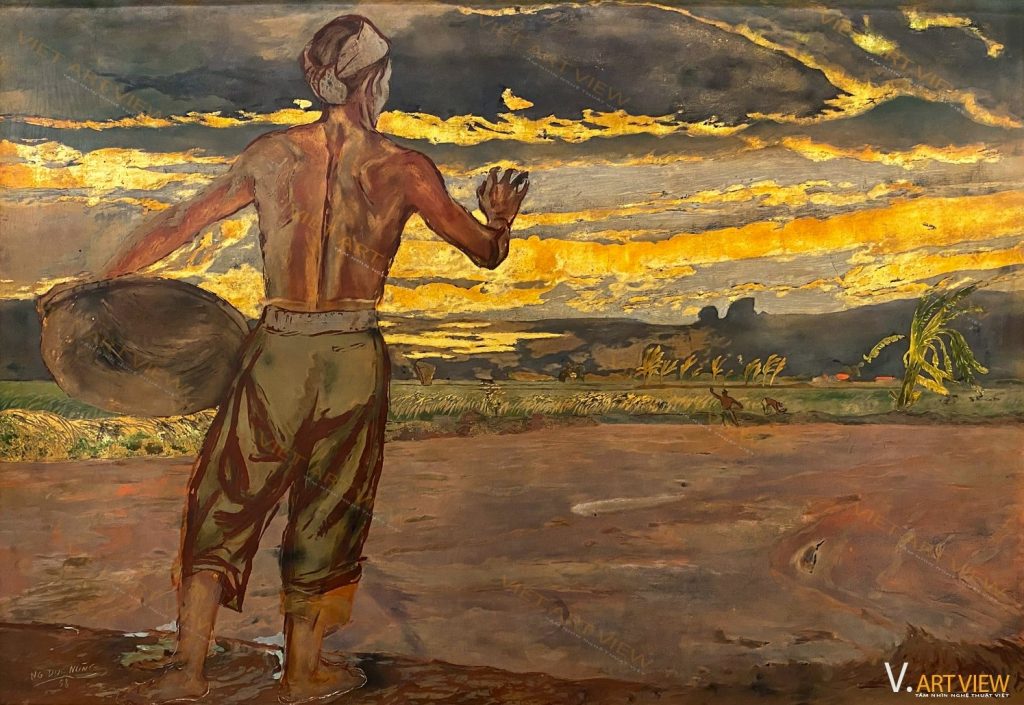In the modern era, many painters like Nguyen Phan Chanh always directed their affection towards the hard-working farmers with a sad face of contenting, typically through the silk paintings Going to the field, Going to transplant in a foggy winter morning. Until the 7th National Fine Arts Exhibition in Hanoi 1958, the work Dawn on the farm by painter Nguyen Duc Nung was a new declaration of aesthetic awareness in the face of reality changing day by day in the countryside with the movement of Exchanging work team, Agricultural cooperatives to own the fields.

Nguyen Duc Nung (1914 – 1983). Dawn on the farm. 1958. Lacquer. 63×91,2 cm.
By looking at the typical image of a farmer, the main character of the painting Dawn on the farm with a tanned muscular bare back, is waving his hand to sow seeds in the field while dawn’s just come.
Painter Nguyen Si Ngoc once commented: “The composition is very bold. Although standing on his back, the details of his bare back and arms are focused on expressing with magical vibes. It’s very light on the cheek, but everything stands superbly like a real person. The right hand is a sufficient movement, too high or low is not valuable.”
In the vast field in the early morning, still deserted, the farmer does not feel lonely, but dignified in the decisive act of sowing seeds. Nguyen Duc Nung wanted to show a symbol of a farmer in the Northern Delta who no longer has doubts on his furrow, the field is in his hands, confidently asserting through the image of a single person in the vast space of dawn.
The composition of the painting is exact and condensed with the steady, strong body lines of the character. The immensity of the field bathed in the dawn light is expressed in gold on a convincing vermilion wooden board.
Painter Nguyen Duc Nung had mastered and manipulated the traditional lacquer language to express a powerful and majestic theme with a new look: strong and satisfy.

Portrait of artist Nguyen Duc Nung (1914 – 1983)
In this painting, Nguyen Duc Nung met again and rediscovered the traditional lacquer language when he returned to Hanoi from Viet Bac war zone in 1958. When making the work, he combined the expression of lacquer from the way of peppering gold powder, grinding and polishing in both heavy, light hands to make shape and color appear as intended. In his hands, the paint palette in Dawn on the farm was a surprisingly successful search, especially in terms of the ability to depict light. The leaves of gold were densely laid, shining brightly, expressing the light of the rising dawn, where the village is still quiet after a long night, with a few streaks of sunlight from the golden yellow. The lacquer color palette steps out of the religious space of the altars, lacquered board, and couplets to take the rich display of the material to show it majestic, imposing.
The golden streak in the work is almost the subject of leading a natural phenomenon in the world, balanced by the warm dark brown of the ground to reduce the splendid golden part. Nguyen Duc Nung had overcome the spirit of meticulous care, certainly following the fine craft thinking of the ancient artisans to reach the harmonious beauty in creative colors. The artist was fascinated by the color of emotional interaction and the mysterious deep weight under the native paint throughout the centuries.
In a neat co-presentation style, the patches of colors running across the heart of the painting represent the sky, the earth, the village, and the trees that glow under the dawn light according to the time scale. In that quiet space appeared the silhouette of a strong farmer waving his hand to sow seeds. This move breaks the horizontal color circuit, regaining an exact balance for the work. In the work, the artist also combined paint mixing techniques to enrich the palette by depicting villages, trees, sun, and earth on the background of traditional paint — black paint, gold, cockroach wings color. On the other hand, thanks to studying and researching the laws of European art about shaping, space, perspective in composition and rendering, Nguyen Duc Nung used the characteristics of gold with full abstraction, convention to express light but still show the depth of the painting space in the work.
Appearing in the lacquer decade 1955- 1965, a period of renaissance of traditional lacquer values in painting, the work Dawn on the farm contains many new messages about content with social and human themes after the 1954 Patriotic war with the ability to express lacquer materials on topics of political value of a sustainable peace time in Vietnam.
A modern theme in the visual style, the structure on the natural level of the socialist realism movement is based on the classical lacquer style, Dawn on the farm is a skillful combination of the value of visual art past- present, classical- modern, the language of lacquer expression for the first time expanded the concept to shape a movement of modern Vietnamese painting in the 60s with the method of socialist realism, a strong, coherent style monolithic in the structure of the subject and the content shown. This is the most typical work of Nguyen Duc Nung in the collection of lacquer paintings in Vietnam Fine Arts Museum.
Photographer Le Vuong
Article by researcher Nguyen Hai Yen
Copyrights belong to Viet Art View







